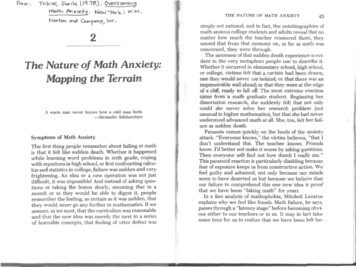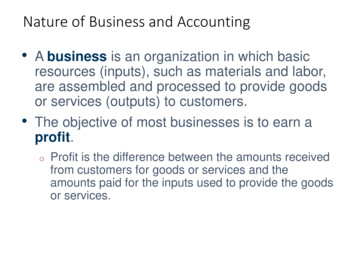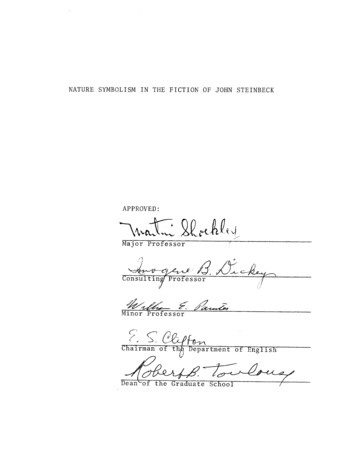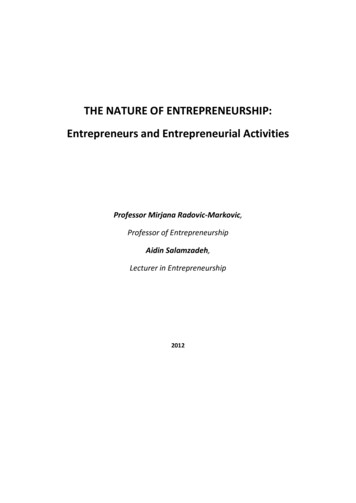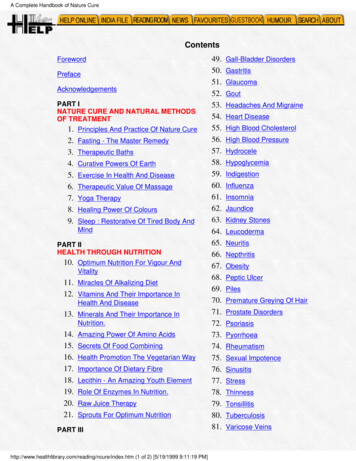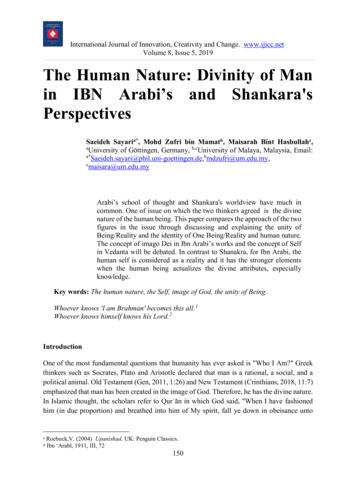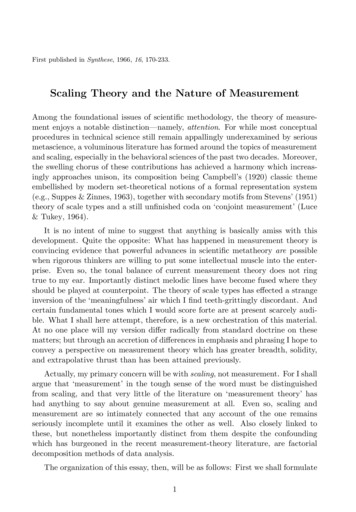
Transcription
First published in Synthese, 1966, 16, 170-233.Scaling Theory and the Nature of MeasurementAmong the foundational issues of scientific methodology, the theory of measurement enjoys a notable distinction—namely, attention. For while most conceptualprocedures in technical science still remain appallingly underexamined by seriousmetascience, a voluminous literature has formed around the topics of measurementand scaling, especially in the behavioral sciences of the past two decades. Moreover,the swelling chorus of these contributions has achieved a harmony which increasingly approaches unison, its composition being Campbell’s (1920) classic themeembellished by modern set-theoretical notions of a formal representation system(e.g., Suppes & Zinnes, 1963), together with secondary motifs from Stevens’ (1951)theory of scale types and a still unfinished coda on ‘conjoint measurement’ (Luce& Tukey, 1964).It is no intent of mine to suggest that anything is basically amiss with thisdevelopment. Quite the opposite: What has happened in measurement theory isconvincing evidence that powerful advances in scientific metatheory are possiblewhen rigorous thinkers are willing to put some intellectual muscle into the enterprise. Even so, the tonal balance of current measurement theory does not ringtrue to my ear. Importantly distinct melodic lines have become fused where theyshould be played at counterpoint. The theory of scale types has effected a strangeinversion of the ‘meaningfulness’ air which I find teeth-grittingly discordant. Andcertain fundamental tones which I would score forte are at present scarcely audible. What I shall here attempt, therefore, is a new orchestration of this material.At no one place will my version differ radically from standard doctrine on thesematters; but through an accretion of differences in emphasis and phrasing I hope toconvey a perspective on measurement theory which has greater breadth, solidity,and extrapolative thrust than has been attained previously.Actually, my primary concern will be with scaling, not measurement. For I shallargue that ‘measurement’ in the tough sense of the word must be distinguishedfrom scaling, and that very little of the literature on ‘measurement theory’ hashad anything to say about genuine measurement at all. Even so, scaling andmeasurement are so intimately connected that any account of the one remainsseriously incomplete until it examines the other as well. Also closely linked tothese, but nonetheless importantly distinct from them despite the confoundingwhich has burgeoned in the recent measurement-theory literature, are factorialdecomposition methods of data analysis.The organization of this essay, then, will be as follows: First we shall formulate1
in considerable generality the definitions of ‘scale’, ‘scale type’, and ‘scale interpretation’, the last being the pivotal concept of scaling theory. Next, we undertake anabstract characterization of factorial decomposition, which differs formally fromscaling only in a few small technical details which, however, reflect a vital methodological distinction. And finally, measurement proper will emerge as but a speciesunder the genus of scale interpretation, albeit by far and away the most importantone. That the discussion will become increasingly programmatic and speculativein its latter stages is an unfortunate necessity for which I ask the reader’s forbearance. The methodological vistas encountered there are so new that I am ableto chart but a few rough compass bearings in terrain which still awaits its pioneers.1 ScalesScaling theory is remarkable for the fact that its cognitive content consists almostentirely of stipulative definitions—no postulates are required, and its major theorems are deductively trivial. To grasp the full significance of these abstractions,however, is apparently no small thing. For the aura of mysterious profundity whichhas come to invest so much of the scaling literature is sustained largely by a dearthof clear thinking about the matters at issue.The essential technical concepts upon which scaling theory rests are ‘property’,‘relation’, ‘function’, and ‘(scientific) variable’. Though all but the last of these arefamiliar notions in logic and mathematics, their review will make an appropriatebeginning if only to introduce present terminology and notation.Background ConceptsWith considerable reluctance, I shall here provisionally adopt an extensional definition of ‘property’ (or, what is essentially the same, ‘attribute’), namely, thatproperties (attributes) are classes of the entities whose properties they are. Thatis, we shall suppose a property P over a domain d to be a subset p of d such that amember d of d has property P iff1 d belongs to p. For example, human ‘baldness’(or ‘being bald’) is to be identified with the class of all bald humans, while overthe domain comprising all chunks of minerals, the property ‘crystalline’ is the classof all crystalline rocks. What is objectionable about this usage, of course, is that‘properties’ are really distinguishing features of the entities which possess them, sothat in principle, properties can be coextensive even though non-identical.2 (Thus1As the reader is doubtlessly aware, ‘iff’ is a standard abbreviation for ‘if and only if’.The difference between properties and classes is often characterized as the difference betweena predicate’s intension and extension, the latter being the class of things which satisfy it whilethe former is held to be the predicate’s meaning. However, I have argued elsewhere (Rozeboom,1962a) that properties are what predicates designate, and must hence be distinguished from both22
if all crystalline rocks were translucent and conversely, we should still deny thatcrystallinity and translucency are the same property of rocks even though theclass of crystalline rocks would be identical with the class of translucent rocks.)However, equating properties with classes has become standard practice in contemporary set-theoretical approaches to scaling, while in this context any technicallyexplicit attempt to preserve the distinction uselessly complicates the analysis atmost points, especially since our intuitive ability to discriminate between coextensive properties fails altogether for abstract domains. (E.g., are ‘being even’ and‘being one greater than an odd number’ the same or different attributes of positive integers?) Hence an extensional introduction to scaling theory can be justifiedpragmatically, especially insomuch as once the extensional version is well understood, the modifications required to do justice to the class/property distinction areminor and obvious. Even so, since the most challenging problems of scaling andmeasurement cannot be expressed at all in extensional terms, I shall differentiatenotationally between (a) sets (classes) which are here truly sets and (b) propertieswhose present set-characterization is only provisional by using boldface symbolsfor the former and italics for the latter. Similarly, as much as possible I shall writepredications in logistical rather than class-membership notation.A relational property, or simply ‘relation’, is a property over a domain of orderedk -tuples of entities, where k is some integer appropriate to the relation in questionand the latter is said, more specifically, to be a ‘k -adic’ or ‘k -ary’ relation. That is,if e1 , . . . , ek are k not-necessarily-distinct sets of entities, then any property overthe product set e1 e2 · · · ek is a k -adic relation.3For example, the binary relation ‘x is the husband of y’, construed extensionally, is the set of all ordered pairs of persons such that the first person is aman, the second is a woman, and the first is married to the second; while theternary numerical relation ‘lies between’ is the set of all triples of numbers suchthat the first is larger than one of the latter two and is smaller than the other.In logistical notation, the formula ‘Rk (e1 , . . . , ek )’ asserts that entities e1 , . . . , ekstand in relation Rk ; whereas in set-theoretical notation this same idea is expressed‘he1 , . . . , ek i r(k) ’, where r(k) is some subset of a k -fold product domain. Whenall the k -tuples which belong to relation r(k) are members of the k -fold productof a set e with itself—i.e., if r(k) ek —we shall say simply that r(k) is a k -aryrelation over e.A function over a set a into a set v may now be defined as any subset φ ofproduct set a v which has the special feature that for each element a in a, therethe predicate’s extension and its meaning.3The reader whose knowledge of set-theoretical terminology is scanty may like to be remindedthat a ‘product set’ e1 e2 · · · ek is the set of all ordered k -tuples such that a k -tuplehe1 , . . . , ek i belongs to e1 · · · ek iff e1 e1 , . . . , ek ek . When e1 , . . . , ek are all the same sete, product set e1 · · · ek may be written more compactly as ek .3
exists one and only one element v of v such that ha, vi φ. The elements of a areknown as the arguments of function φ, while if a is an argument of φ, the elementv of v for which ha, vi φ is the value of φ for a. Correspondingly, we may callsets a and v the argument domain and value domain, respectively, of function φ,while the set v′ of those elements of v which are actually a value of φ for someargument is the range of φ.We shall adopt the compound symbol ‘φa’, in which the function symbol is prefixed to an argument term ‘a’ without parentheses around the latter, to designatethe value of φ for a.A function φ from argument domain a into value domain v also defines amapping of properties, relations, and other constructions on a into correspondingproperties, etc., on v. This idea may be made notationally explicit as follows: Ifak is a k -tuple of a-elements (i.e., ak ak ), then ‘φ ak ’ designates the k -tuple invk whose components are the values of φ for the corresponding components of ak ,i.e.,Def. 1.φ ha1 , . . . , ak i def hφa1 , . . . , φak i;while if r(k) is a k -ary relation over a (i.e., r(k) ak ), then φ r(k) is the set ofk -tuples in vk into which φ maps the k -tuples in r(k) —i.e.,Def. 2. φ r(k) def The set which contains a given k -tuple v k iff v k is the valueof φ for some k -tuple in r(k) ,or expressed logistically,Def. 2a.φ Rk (xk ) def ( ak )[Rk (ak ) · xk φ ak ]where Rk and φ Rk are k -adic relations over the argument and value domain,respectively, of φ. The symbol ‘φ ’ in itself may be construed to designate thefunction whose argument domain a is the set of all subsets of all product setsof φ’s argument domain a, whose range v′ is the set of all subsets of all productsets of φ’s range v′ , and whose value for a given argument in a is defined byDef. 2.4 We may call extended domains a , v , and function φ the ‘first-leveldevelopments’ of a, v, and φ, respectively.This implies that when I write ‘v k φ ak ’ (cf. Def. 1) for k -tuples v k in v and ak ina what I really meant is that φ maps the unit class of ak into the unit class of v k . However,no harm will be done, and much notational simplification achieved, if the same symbol is usedambiguously to designate both an entity and its unit class. Also for simplicity, I shall write ‘φ R’for the set of relations into which φ maps the elements in a set R of relations over φ’s arguments.(Strictly speaking, the proper notation would be ‘φ R’.)4k4
The v-relation φ r(k) into which a function φ from a into v maps a k -aryrelation r(k) over a may be referred to as the image in v of r(k) under φ, or ‘theφ-image of r(k) ’ for short. Conversely, if q(k) is a relation over φ’s range, the set ofall k -tuples in ak whose φ-images are in q(k) may be called the contraimage in aof q(k) under φ (for short, ‘the φ-contraimage of q(k) ’) and symbolized ‘φI q(k) ’).That is, expressed logistically,Def. 3φI Qk (xk ) def Qk (φ xk ).The symbol ‘φI ’ itself may be thought to name the function—call it φ’s ‘firstlevel contra-development’—whose argument domain is the first-level developmentof φ’s range, whose value domain is the first-level development of φ’s argumentdomain, and whose value for any given argument is the latter’s φ-contraimage. Animmediate consequence of φI ’s definition is thatTheorem 1. For any relation q(k) over the range of a function φ, and any k -tupleak of φ’s arguments, the φ-image of ak belongs to q(k) iff ak belongs to theφ-contraimage of q(k) .A function is said to be one-one if it has a different value for every differentargument, and is many-one otherwise. If φ is a one-one function from a into v,there exists a function from the range v′ of φ into a, designated ‘φ 1 ’ called theinverse of φ, such that the value of φ 1 for an argument v in v′ is the element of awhose value of φ is v. It is easily seen that whenever φ 1 exists, an argument a ofφ is the value of φ 1 for an element v of φ’s range iff a is the φ-contraimage of v,and hence, more generally, that φ 1 φI . Moreover, since v φa and a′ φ 1 vjointly entail a′ a,Theorem 2. If φ is a one-one function, then any relation r(k) over φ’s argumentdomain is the φ-contraimage of its φ-image—i.e., for any relations r(k) and q(k) ,r(k) φ 1 q(k) iff q(k) φ r(k) . Corollary: If φ is a one-one function, then forany relation r(k) and any k -tuple ak of φ’s arguments, ak belongs to r(k) iff theφ-image of ak belongs to the φ-image of r(k) .If φ is not one-one, however, the biconditionals in Theorem 2 and its corollary areweakened to conditionals.Finally, we note that if φ2 is a function from set m into set v while φ1 is afunction from set a into a subset of m, then there exists a function from a into v,designated ‘φ2 φ1 ’ and known as the product or composition of φ2 with φ1 , whosevalue for an argument a is the element of v which is the value of φ2 for the elementof m which is the value of φ1 for a. That is, φ2 φ1 a is the value of φ2 for elementφ1 a of m.5
Even so, scaling and measurement are so intimately connected that any account of the one remains seriously incomplete until it examines the other as well. Also closely linked to these, but nonetheless importantly distinct from them despite the confounding which has burgeoned in the recent measurement-theory literature, are factorial decomposition methods of data analysis.


